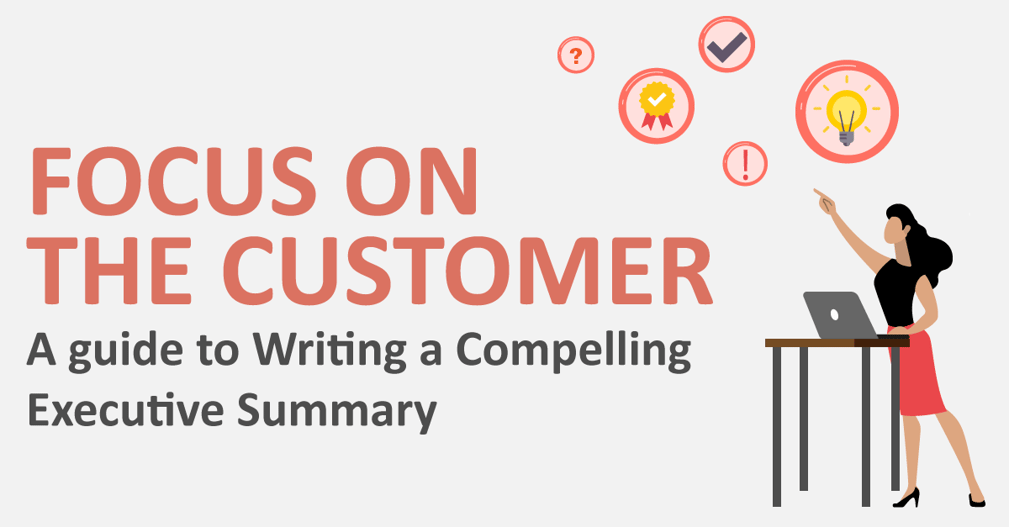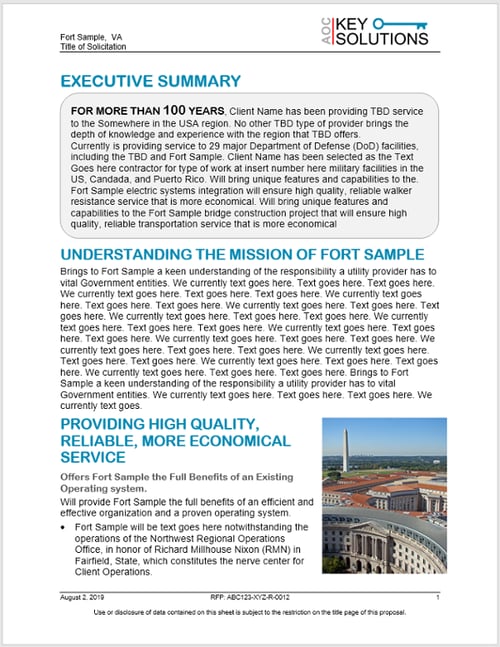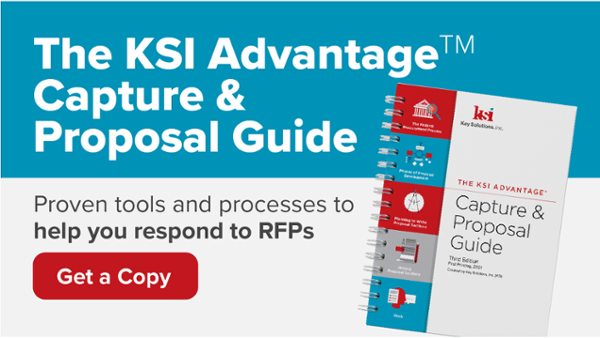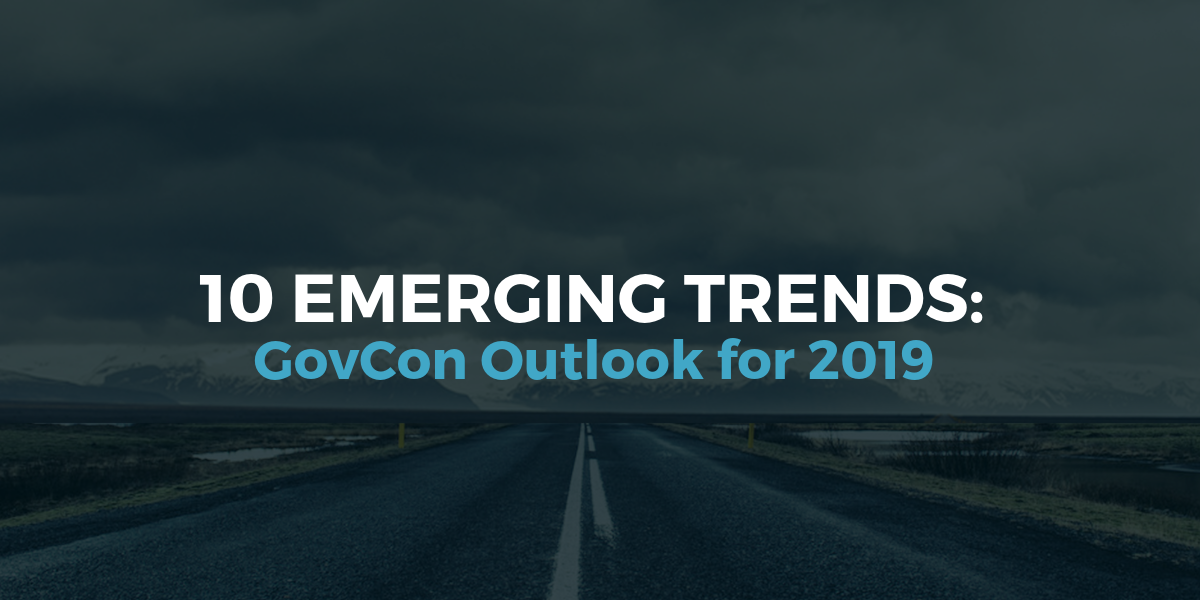
You have just been tasked with writing the executive summary for a must-win proposal.
The stakes are high, the pressure is real, and the scrutiny will be intense. Here are eight guidelines for writing a clear, concise, and persuasive document.
1. Start with the Customer
Executive summaries set the tone for the entire proposal.
Many writers are aware of this and immediately fall into the trap of trying too hard to make every sentence a home run. The result? They strike out using too many superlatives that have lost meaning over time, such as “world-class” “or “cutting edge.”
Avoid this trap and start with a customer focus:
- What is the customer’s vision?
- How does the procurement fit within that vision?
- How does the proposal benefit the customer within the context of that vision?
2. Simplify How it is Organized
Two common ways to organize an executive summary are:
- By customer concern, starting with the highest priority
- As a summary of the proposal.
Other methods may work depending on specific proposal requirements. No matter how you organize it, it’s best to keep it simple and reader-friendly. An advantage to organizing by customer concern is that the major topics will directly address issues likely to resonate with the evaluator.
Executive summaries that follow the order of the proposal offer a solid introduction and forecast the content to follow. Either method will work. However, when RFPs dictate a complex organization to the proposal with sections that do not logically follow one another, it is best to organize the executive summary by customer concern.

3. Distill, Don’t Explain
Most Government evaluators do not look forward to reading pages and pages of detailed proposal content from multiple offerors.
Your goal in the executive summary is to create a positive first impression and make the evaluator want to read the rest of the proposal
- Begin with a high-level theme that includes customer vision, the specific procurement, and how the team will meet the customer’s needs.
- Provide a preview sentence forecasting the main topics to be discussed such as customer needs and hot buttons, key points, issues, and challenges.
Additional topics may include introducing the team, organizational structure, and technical approach tied to customer hot buttons. In choosing topics, remember that you will need to distill the essence of the proposal down to a few pages. Present information that matters, and discard the things that are not essential to the offer.
4. Tie Topics to Customer Needs
Next, cover each topic in the order presented in the preview sentence. For each, identify the benefits and features of the approach and provide proof points for assertions.
Emphasize major discriminators and key selling points tied to customer needs. Include visuals to convey information concisely. Address customer hot buttons—what keeps the customer up at night? How does your team’s approach resolve their concerns?
Consider concluding with a bulleted list of “Why Choose Company X.”
5. Start Early and Revise
Now that you have a strategy for organizing the section, you may wonder: is it best to write the executive summary first—before the proposal is written—or last? The answer is yes to both.
Develop the first draft early in the process based on the overall win strategy. Use the initial draft as a capture document to give the team a solid overview and win themes. Then, iteratively improve the executive summary as the RFP is released, information is gathered, and solutions are matured. Use feedback from color team reviews to your advantage.
6. Creativity + Collaboration
Creativity is important, but so is hard work.
Do not sit alone in an office with the win strategy and try to dream up a creative story. Instead, talk with people who bring customer insight and get their take on what is most important to the customer.
Ask open-ended questions to better understand the nuances and underlying customer drivers—you might be surprised by what you find. Scour the proposal during each color-team review—you may discover compelling data or features that were not available early in the process.
For example, perhaps data has come in that shows your team not only has a good reliability record, but has a significantly better record than the industry average—demonstrated by quantitative data!
Review the Past Performance volume late in the process to uncover recent accomplishments, success stories, and commendations that can add depth to proof statements.
7. Achieve More with Less
Stay within no more than two to five pages.
Some time ago I was asked to revise an eight-page executive summary. The client had asked the Government about page count, and the Government responded with a limit of four pages for the executive summary.
To reduce page count, my first step was to read and evaluate the current draft, highlighting areas that were particularly compelling. Next, I reviewed the latest version of the proposal, and found several key features that were essentially hidden gems, buried in the technical approach and past performance volumes. I added these features and discarded everything that I had not highlighted as compelling. Still, slightly over page count, I purged more than 90 percent of the adjectives.
The result was a straightforward executive summary that was received favorably in the final color review. The client ultimately went on to win the proposal.
8. Make it Easy to Read
Finally, when writing the executive summary, make sure it is reader-friendly for upper-level, non-technical decision-makers. Is it coherent to a layperson?
To find out, consider having a non-technical person review the document. Ask this person to explain what your team is offering and what need it meets. If the person can easily describe it, that is a very good sign. If not, you have more work to do.








